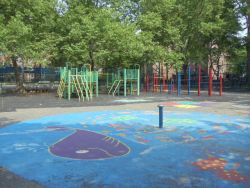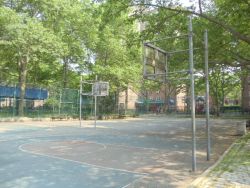Langston Hughes Playground
Langston Hughes Playground
What was here before?
Originally settled by Dutch farmers in the late 1600s, the area was first named Nieuw Haarlem. After the American Revolution (1775-1781), the neighborhood’s agrarian yield began to wane, resulting in the relocation of many residents to southern Manhattan’s more industrial-oriented areas. In the 1880s, with the addition of elevated trains and tenement houses, the neighborhood began to thrive once more.
How did this site become a playground?
In an attempt to combat housing insecurity in Harlem, the New York City Housing Authority in 1933 built the St. Nicholas Houses, a multi-tenement complex between West 127th and 131st Streets. To address the needs of local children, in 1953 the Housing Authority leased two plots of land along Adam Clayton Powell Jr. Boulevard to NYC Parks for playground construction. The first playground, St. Nicholas Houses Playground South, opened in April 1953. The second site, St. Nicholas Houses Playground North, opened shortly thereafter, and together the two sites contained a wading pool, public restroom, sand pit, and courts for basketball, paddleball, handball, and shuffleboard.
In 2018, the playground was reconstructed as part of NYC Parks’ Community Parks Initiative, a multi-faceted program to invest in under-resourced public parks and increase the accessibility and quality of parks throughout the five boroughs. The renovation added new multi-generational play equipment, spray showers, and a new entrance.
Who is this playground named for?
In 2020, the park was renamed as part of an NYC Parks initiative to expand the representation of African Americans honored in parks. The park honors distinguished poet, novelist, and playwright Langston Hughes (1901-1967). Hughes grew up in the Midwest and moved to New York City to attend Columbia University. He left after one year due to racial prejudice from staff and peers and later graduated in 1929 from Lincoln University, a Historically Black University in Pennsylvania, before returning to New York City.
Hughes is known as a leading figure in the Harlem Renaissance, a cultural mecca for Black intellectuals and artists in the early 20th century. He wrote about African American life between the 1920s and 1960s, including The Negro Speaks of Rivers, Montage of A Dream Deferred, and Not Without Laughter, which won the Harmon Gold Medal for Literature.
Hughes lived in Harlem longer than any other place in his life and resided at nearby 20 East 127th Street for twenty years. The site was landmarked in 1989. He died in 1967 and leaves a literary legacy largely inspired by Harlem. His ashes are interred under the lobby floor of the New York Public Library's Schomburg Center for Research in Black Culture, beneath a mosaic cosmogram that includes lines from his classic poem “The Negro Speaks of Rivers.
Check out your park's Vital Signs
Clean & Safe
Green & Resilient
Empowered & Engaged Users
Share your feedback or learn more about how this park is part of a
Vital Park System



